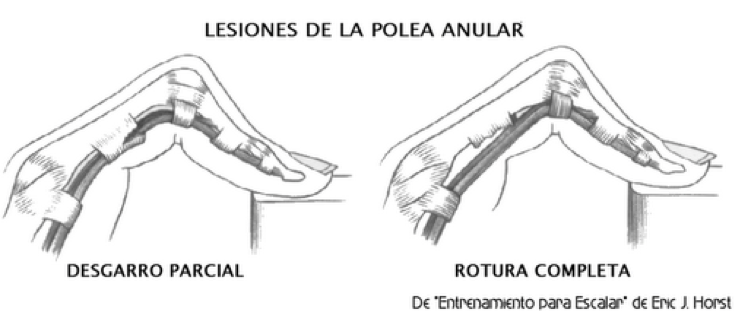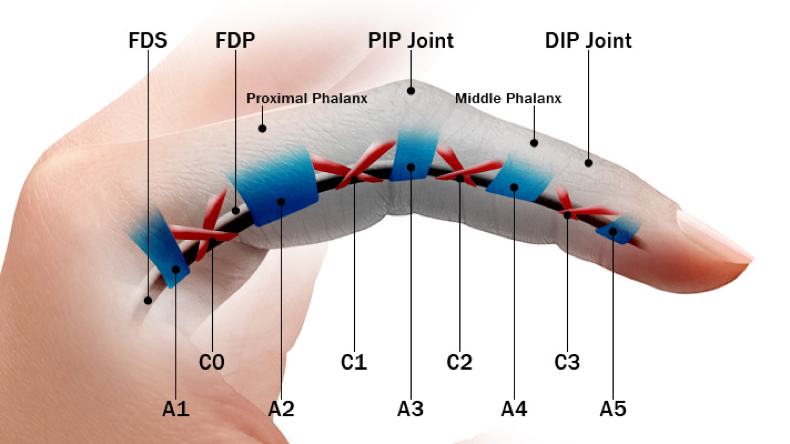What are they?
Pulleys are anatomical structures found in the fingers and their main function is to keep the tendons near the bone of each finger. Each finger has 5 ring pulleys (A1, A2, A3, A4 and A5) and 4 cruciform pulleys (C0, C1, C2 and C3) that prevent the tendons from separating from the bone (lesion known as the bowstring), allowing efficient point of support for the flexion and extension of the fingers in climbing.
Types of injury
There are two types of injuries that the pulleys can suffer in climbing:
- Partial tear: the pulley does not break completely.
- Complete break: the pulley breaks and loses its function.

Causes
In most cases, pulley breaks occur when we abuse grip in "arching". When we subject the pulleys to a lot of tension climbing with intense loads repetitively and without adequate recovery periods, we can feel pain in the area of the pulleys. The pain indicates that there may be inflammation and therefore we may end up producing partial or complete tears. In some cases it is possible to feel or hear a "click" while performing a high-intensity tonnage and this could indicate a possible injury.
According to the studies, the A2 and A4 pulleys are the largest and most important in the flexion of the fingers when we climb and, therefore, the ones that are most injured.
Incidence
Climbing is a unique sport from the anatomical and biomechanical point of view, because our body is in principle designed to move and support weight in the lower extremities. According to studies, it is estimated that 75% of climbers will suffer an upper limb injury, of which 60% are hand and wrist injuries and 30-50% of these are closed lesions of the pulleys of the flexor tendons. In elite athletes it is described that 33% suffer finger tendon injuries, with an 8% incidence of A2 pulley rupture.
Diagnosis
In most cases it is the climber himself who goes to a specialist, due to the pain, although sometimes he is not given the importance he has until the injury is acute. It is advisable, therefore, to go to a professional if there is suspicion of injury.
The patient refers to a pain located mainly on the front of the finger, which becomes more acute when it scales and tenses the fingers (especially when it arches), this being a physical test that may suggest this diagnosis. Given these suspicions, it is advisable to perform an ultrasound (choice test) to assess the state of the pulley.
Treatment
It depends on the different degrees of breakage, number of pulleys injured and other factors intrinsic to the person (always under the supervision of a doctor and a health professional). In general it can be said that in case of partial rupture (grades I, II, and III) conservative treatment is recommended, based on rest, ice, medication and orthosis (with inelastic tape or thermoplastic splint).
In case of complete rupture or failure of conservative treatment, surgery and subsequent physiotherapy treatment would be indicated to avoid adhesions and possible complications. Normally the surgical reconstruction allows to return to activity.
Prevention
There are several prevention exercises for this type of injury, but a very indicated exercise for climbing are suspensions. By means of this type of exercises we can reinforce anatomical structures such as the flexor tendons, and in this way we could make more use of the grip in extension, being able to avoid in many cases the abuse of the arch.
In the following link we can consult a series of exercises in suspension proposed by Eva López, an eminent in the research and development of training and prevention of injuries in climbing: https://eva-lopez.blogspot.com.es/2013/04/videos-de-entrenamiento-de-suspensiones.html
Can we climb with partial breaks?
You can climb with partial breaks or if we are in the process of rehabilitation, as long as we consult with the appropriate professionals. In these cases it is advisable to use specific and functional bandages. On the other hand, it is not convenient to abuse the bandages, since it would be convenient for them to support the same loads that they had in their previous state. Therefore, we would have to start climbing without bandage when the right professional tells us that the pulleys are sufficiently rehabilitated.
Bandage
The following video shows a specific and functional bandage for the pulley bandage:
Bibliography
- https://www.archclimbingwall.com/magazine-backend/2016/4/15/to-tape-or-not-to-tape
- https://www.ukclimbing.com/articles/features/injury_management_and_prevention_fingers-6193
- Klauser A, Frauscher F, et al. Finger pulley injuries in extreme rock climbers.2002
- Zafonte B, Rendulic D. Flexor pulley system: anatomy, injury, and management. J hand Surgery 2014.
- https://eva-lopez.blogspot.com.es/2013/04/videos-de-entrenamiento-de-suspensiones.html


